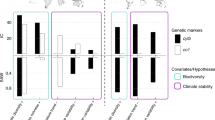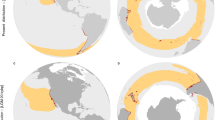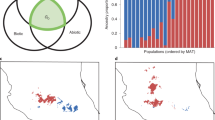Abstract
Global climate change (GCC) significantly affects distributional patterns of organisms1, and considerable impacts on biodiversity are predicted for the next decades. Inferred effects include large-scale range shifts towards higher altitudes and latitudes2, facilitation of biological invasions3 and species extinctions1,3. Alterations of biotic patterns caused by GCC have usually been predicted on the scale of taxonomically recognized morphospecies1. However, the effects of climate change at the most fundamental level of biodiversity—intraspecific genetic diversity—remain elusive4. Here we show that the use of morphospecies-based assessments of GCC effects will result in underestimations of the true scale of biodiversity loss. Species distribution modelling and assessments of mitochondrial DNA variability in nine montane aquatic insect species in Europe indicate that future range contractions will be accompanied by severe losses of cryptic evolutionary lineages and genetic diversity within these lineages. These losses greatly exceed those at the scale of morphospecies. We also document that the extent of range reduction may be a useful proxy when predicting losses of genetic diversity. Our results demonstrate that intraspecific patterns of genetic diversity should be considered when estimating the effects of climate change on biodiversity.
This is a preview of subscription content, access via your institution
Access options
Subscribe to this journal
Receive 12 print issues and online access
$209.00 per year
only $17.42 per issue
Buy this article
- Purchase on Springer Link
- Instant access to full article PDF
Prices may be subject to local taxes which are calculated during checkout




Similar content being viewed by others
References
Thomas, C. D. et al. Extinction risk from climate change. Nature 427, 145–148 (2004).
Hill, J. K., Griffiths, H. M. & Thomas, C. D. Climate change and evolutionary adaptations at species’ range margins. Annu. Rev. Entomol. 56, 143–159 (2011).
Sala, O. E. et al. Biodiversity—Global biodiversity scenarios for the year 2100. Science 287, 1770–1774 (2000).
Habel, J. C., Rodder, D., Schmitt, T. & Neve, G. Global warming will affect the genetic diversity and uniqueness of Lycaena helle populations. Glob. Change Biol. 17, 194–205 (2011).
Bickford, D. et al. Cryptic species as a window on diversity and conservation. Trends Ecol. Evol. 22, 148–155 (2007).
Fraser, D. J. & Bernatchez, L. Adaptive evolutionary conservation: Towards a unified concept for defining conservation units. Mol. Ecol. 10, 2741–2752 (2001).
Schmidt-Kloiber, A. & Hering, D. (eds) The Taxa and Autecology Database for Freshwater Organisms version 4.0 (2011); available at http://www.freshwaterecology.info.
IPCC, Climate Change 2001: The Scientific Basis (eds Houghton, J. T. et al.) (Cambridge Univ. Press, 2001).
Pauls, S. U., Lumbsch, H. T. & Haase, P. Phylogeography of the montane caddisfly Drusus discolor: Evidence for multiple refugia and periglacial survival. Mol. Ecol. 15, 2153–2169 (2006).
Schmitt, T. Molecular biogeography of Europe: Pleistocene cycles and postglacial trends. Front. Zool. 4, e11 (2007).
Engelhardt, C. H. M., Haase, P. & Pauls, S. U. From the Western Alps across Central Europe: Postglacial recolonisation of the tufa stream specialist Rhyacophila pubescens (Insecta, Trichoptera). Front. Zool. 8, e10 (2011).
Taubmann, J. et al. Modelling range shifts and assessing genetic diversity distribution of the montane aquatic mayfly Ameletus inopinatus in Europe under climate change scenarios. Conserv. Genet. 12, 503–515 (2011).
Hampe, A. R. & Petit, J. Conserving biodiversity under climate change: The rear edge matters. Ecol. Lett. 8, 461–467 (2005).
Scriber, J. M. Impacts of climate warming on hybrid zone movement: Geographically diffuse and biologically porous ‘species borders’. Insect Sci. 18, 121–129 (2011).
Hickerson, M. J. et al. Phylogeography’s past, present, and future: 10 years after Avise, 2000. Mol. Phylogenet. Evol. 54, 291–301 (2010).
Hebert, P. D. N., Penton, E. H., Burns, J. M., Janzen, D. H. & Hallwachs, W. Ten species in one: DNA barcoding reveals cryptic species in the neotropical skipper butterfly Astraptes fulgerator. Proc. Natl Acad. Sci. USA 101, 14812–14817 (2004).
Franklin, J. Moving beyond static species distribution models in support of conservation biogeography. Divers. Distrib. 16, 321–330 (2010).
Hughes, J. M. Constraints on recovery: Using molecular methods to study connectivity of aquatic biota in rivers and streams. Freshwater Biol. 52, 616–631 (2007).
Hughes, R. A., Inouye, B. D., Johnson, M. T. J., Underwood, N. & Vellend, M. Ecological consequences of genetic diversity. Ecol. Lett. 11, 609–623 (2008).
Lewontin, R. C. The Genetic Basis of Evolutionary Change (Columbia Univ. Press, 1974).
Davis, M. B. & Shaw, R. G. Range shifts and adaptive responses to quaternary climate change. Science 292, 673–679 (2001).
Chown, S. L. et al. Adapting to climate change: A perspective from evolutionary physiology. Clim. Res. 43, 3–15 (2010).
Lillehammer, A. Norwegian stoneflies. II. Distribution and relationship to the environment. Nor. Entomol. Tidsskr. 21, 195–200 (1974).
Vogler, A. P. & Monaghan, M. T. Recent advances in DNA taxonomy. J. Zool. Syst. Evol. Res. 45, 1–10 (2007).
Zhou, X., Adamowicz, S., Jacobus, L., DeWalt, R. E. & Hebert, P. D. N. Towards a comprehensive barcode library for arctic life—Ephemeroptera, Plecoptera, and Trichoptera of Churchill, Manitoba, Canada. Front. Zool. 6, e30 (2009).
Monaghan, M. T. et al. Accelerated species inventory on Madagascar using coalescent-based models of species delineation. Syst. Biol. 58, 298–311 (2009).
Drummond, A. J. & Rambaut, A. BEAST: Bayesian evolutionary analysis by sampling trees. BMC Evol. Biol. 7, e214 (2007).
Ezard, T., Fujisawa, T. & Barraclough, T. Species delimitation by threshold statistics version 1. https://r-forge.r-project.org/projects/splits/ (2009).
Thuiller, W., Lafourcade, B., Engler, R. & Araújo, M. B. BIOMOD—a platform for ensemble forecasting of species distributions. Ecography 32, 369–373 (2009).
Marmion, M., Parviainen, M., Luoto, M., Heikkinen, R. K. & Thuiller, W. Evaluation of consensus methods in predictive species distribution modelling. Divers. Distrib. 15, 59–69 (2009).
Acknowledgements
We thank J. Hughes (Griffith University), A. Mulch (BiK-F), M. Pfenninger (BiK-F) and K. Schwenk (University of Landau) for helpful comments. This study was financially supported by the research funding program LOEWE—Landes-Offensive zur Entwicklung Wissenschaftlich-ökonomischer Exzellenz of Hesse’s Ministry of Higher Education, Research, and the Arts.
Author information
Authors and Affiliations
Contributions
M.B., C.N. and S.U.P. conceived the research. M.B., C.N. and S.U.P. conducted the research. S.D., C.H.M.E., P.H., S.L., J.S., K.T., M.B. and S.U.P. contributed new reagents/analytic tools. M.B. and S.D. analysed the data. M.B., C.N. and S.U.P. wrote the manuscript. C.N. and S.U.P. contributed equally to the study. All authors discussed the results and commented on the manuscript.
Corresponding authors
Ethics declarations
Competing interests
The authors declare no competing financial interests.
Supplementary information
Supplementary Information
Supplementary Information (PDF 3079 kb)
Rights and permissions
About this article
Cite this article
Bálint, M., Domisch, S., Engelhardt, C. et al. Cryptic biodiversity loss linked to global climate change. Nature Clim Change 1, 313–318 (2011). https://doi.org/10.1038/nclimate1191
Received:
Accepted:
Published:
Issue Date:
DOI: https://doi.org/10.1038/nclimate1191
This article is cited by
-
Transnational conservation to anticipate future plant shifts in Europe
Nature Ecology & Evolution (2024)
-
Performance of inhomogeneous Poisson point process models under different scenarios of uncertainty in species presence-only data
Environmental Systems Research (2023)
-
Isolated on sky islands: genetic diversity and population structure of an endangered mountain lizard
Conservation Genetics (2023)
-
Comparative environmental RNA and DNA metabarcoding analysis of river algae and arthropods for ecological surveys and water quality assessment
Scientific Reports (2022)
-
Stoneflies in the genus Lednia (Plecoptera: Nemouridae): sentinels of climate change impacts on mountain stream biodiversity
Biodiversity and Conservation (2022)



